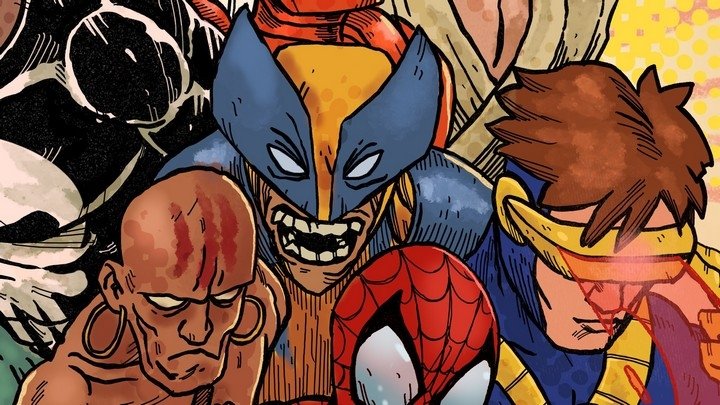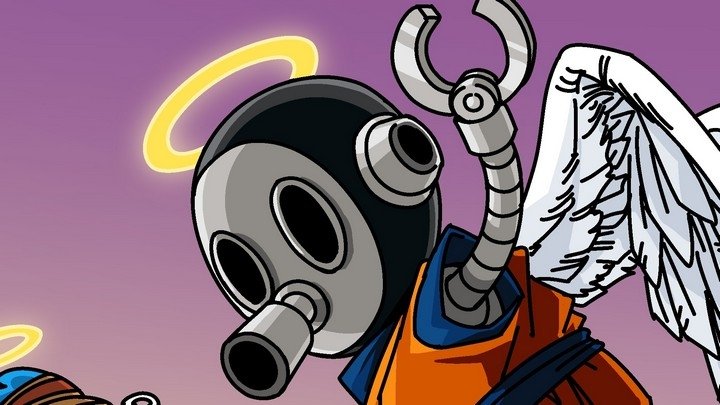Replicade and Numskull deliver more tiny arcade excellence with Street Fighter II and Galaga
Insert contrasting small size/big fun clichés here.
The fact that standalone replica arcade machines don't simply exist but comprise an entire market segment at multiple scales indicates that we, as a society, have hit peak retro. (Obviously, I'm all-in for as long as it lasts.) With options ranging from tiny (the MyArcade line) to Arcade1UP's space-hogging 3/4 scale replica cabinets, you have a shocking number of options available right now for enjoying classic arcade games on standalone devices.
That said, there's no such thing as perfection with these products. Each and every one of them suffers from some sort of nagging flaw ranging from minor nuisance to absolute deal-breaker. On the deal-breaker side, there's the shoddy emulation and blatant inaccuracy of MyArcade's lineup; not only are they built poorly, the "arcade games" featured on those systems... aren't. They're actually the NES ports of the arcade games, making MyArcade the lousiest way to play frequently mediocre arcade conversions. At the higher end, Arcade1UP's jumbo cabinets feature proper arcade ROMs but have suffered from questionable build quality—panels that don't sit flush with one another, decals that quickly rub away, and analog-style controls without proper responsiveness or range of motion. With prices creeping upward to the $500 mark on those devices as the company delves into expensive licenses like Star Wars, Arcade1UP can be a tough sell, too.
For my money, I've found the most comfortable balance between quality, authenticity, and price in two lines of products: The 1/6 scale Replicade line from NewWaveToys, and the 1/4 scale Quarter Arcade line from Numskull. Neither comes cheap—Replicade seems to have settled in around $120 per unit, and Quarter Arcade at about $160—but the price reflects a commitment to quality, accuracy, and loving detail.
This fall, we have one new offering from each line. Galaga from Quarter Arcade and Street Fighter II from Replicade. Neither is quite perfect, but both are great.

Both are incredibly accurate despite their diminutive scale. The shape, proportions, screen sizes, controller layouts, decals—everything. The fidelity here sets these mini-cabinets apart from their competitors. Arcade1UP tends to slather its cabinets with a motley array of logos and futz around with control layouts to accommodate multiple titles (often with totally different input requirements), while MyArcade... well, I'm not really sure what they're trying to do, honestly. These mini-cabinets, on the other hand, could pass as the real thing; a photo of these things without any sort of additional object for a scale comparison can shockingly convincing.
That painstaking care permeates both of these cabinets, all the way down to the satisfyingly tactile microswitches in the Street Fighter II replica cabinet.

Of all the mini-machines slated for release over the next year or so—both NewWaveToys and Numskull appear to be ramping up their output in the near future—Galaga has been the one I've most been looking forward to. I have many fond memories of standing in front of the original cabinet back in the days when I was barely tall enough to see the screen, and the simple sight of this faithfully scaled-down reproduction of the one of the greatest arcade games of all time sets my nostalgia neurons to firing.
I will say that the Quarter Arcade Galaga doesn't quite live up to my hopes, but its failings are fairly specific and ultimately pretty much amount to nitpicking. Certainly the machine looks the part—it captures every element of the real thing beautifully, from the kick-panel decal of featuring the Galagan flagship to the fact that the logo marquee lights up but the quarter-slot indicators don't (as they were decals rather than illuminated buttons on the Midway cabinet).
Speaking of Midway, that is the one notable point of difference between the classic upright and this one—they've scrubbed the Midway logo from the side decal, leaving a blank blue spot that thankfully blends right into the design. Unless you knew to look for it, you'd never notice its absence.

Even the front panel has the proper toothy, matte texture, onto which the original scoring and play instructions have been silkscreen in exquisite detail. Despite the physical similarities between Midway's Pac-Man and Galaga cabinets, they weren't identical, and Numskull didn't simply re-deco their Pac-Man release from last year here. The shapes of the mini-machines are subtly different, with the most noticeable difference between the two actually coming in a part of the cabinet hardly anyone ever saw: The slope of the machine's top as it arches around to the back.

Even the back looks faithful to the original machine, which is wholly unnecessary. You didn't see cabinets like Galaga in a free-standing situation, but the upper speaker ports and the twin sets of two-by-two holes (presumably for ventilation) are carried forward here. The big change, obviously, is the addition of a power switch, volume knob, and micro-USB charging port near the replica's base. As with Pac-Man, Galaga includes an internal battery with pretty respectable life, but you can also keep it plugged in and running permanently in demo mode if you prefer. The original arcade attract mode didn't include many sounds, but you can choose to mute the attract if you leave the machine running on display to minimize the cacophony that will inevitably result once you have a few of these set up.
(The semi-gloss black of both cabinets tend to be fingerprint magnets, as you can see here, but I've come to accept that as an unavoidable reality of modern premium electronics. They're beautiful, and please do not ever touch them with your bare hands.)

The control panel deviates very slightly from the otherwise perfect proportions of this replica. The fire button has been designed with usability in mind, which means that it doesn't sit properly flush to the control panel. Instead, it sticks up more and looks "fatter" than it would on a real machine, a concession made for usability. The joystick, which is properly constrained to left-right motions only, has been built with a microswitch that results in a noticeable click when used—not quite the same as the deeper thudding sound of a real Galaga stick being worked vigorously, but satisfying in its own way. The three buttons (fire and player selection) lack a microswitch and have a softer feel to their action, but this doesn't affect gameplay.
The one shortcoming to this cabinet, as on the Quarter Arcade Pac-Man, is the screen quality. Once again, the LCD Numskull used here lacks the ability to create deep blacks. It looks washed out, which is a real disappointment. A big part of the appeal of these golden-age Namco games was the vivid phosphorescent CRT glow of the sprites and background details against the pitch black of the original screens.

That's totally lost here. Worse, the screen has a shallow viewing angle which causes details to become muddled unless you look at it straight-on. If you stray too far from center, you'll even notice an inverse ringing effect where certain illuminated pixels appear to be darker than the black of the background. You can see it in the photograph above with the flagships near the top of the screen—their medium grey appears to be blacker than the void of space.
This issue doesn't ruin the cabinet or negate all the care that went into the rest of the product, but it does feel like Numskull has undermined the premium appeal of an otherwise excellent product by using cheap (or shoddy, anyway) screens—and since the whole point of this affair is be able to play the original Galaga ROM in a faithfully scaled-down replica of the original cabinet, it's frustrating that the central appeal of the system also doubles as its one significant pain point. Hopefully, Numskull will address this flaw in future releases.

Thankfully, these screen issues don't affect Replicade's Street Fighter II 1/6-scale cabinet. It could be a matter of the proportionately smaller screen revealing fewer flaws, or it could be that the more detailed and textured visuals obscure viewing angle issues better. Maybe Street Fighter II's colorful design and low-contrast art work better on these tiny screens. Or maybe NewWaveToys just sourced better-quality components. In any case, this Replicade looks fantastic in motion and makes a case for reproducing more advanced arcade titles than the usual early ’80s fare we tend to see in these lines.
Of course, Street Fighter II isn't just more advanced than Pac-Man and Galaga, it's way more advanced. And that poses its own challenges...

...namely, that there's no way to even begin to faithfully reproduce the arcade cabinet's control panel at 1/6 scale. Street Fighter II required an eight-way joystick and six buttons, and trying to shrink that down to work on a 12" tall replica was not going to happen. Replicade made a concession to scale with last year's Tempest cabinet, shipping it with two interchangeable spinner knobs—one proportionate to the cabinet and too small to be practical, one oversized but usable. This setup is a whole different matter, though, and NewWaveToys decided to err on the side of common sense. Rather than trying to squeeze a six-button scheme into a two-up arrangement on a toy-sized cabinet, they instead built the Street Fighter II Replicade with a single-player control panel and added support for a second player in the form of a second USB-powered arcade stick that can be plugged into the back of the unit.
This works a lot better than it really has any right to.

As a nice touch, the back of the cabinet includes a storage cubbyhole for the second controller and cable, complete with a transparent door and—as a completely ridiculous gracenote—a couple of colored LEDs inside the storage space to add a little extra flair. Even if you just keep the cabinet on display, the LEDs cast a bit of light against any wall or other surface behind them to help reinforce that arcade feel.

Better yet, as a USB-powered device, the second player stick doesn't only work with the Replicade cabinet. Any device capable of accepting USB controllers should work with the stick. Certainly it works perfectly with OpenEmu, and while I haven't had an opportunity to test it with something like a MiSTER, there's no reason it shouldn't do the trick there.
And it's a great little stick! All seven buttons and the eight-directional stick use microswitches and have a great, responsive feel. I do find I tend to want to drift toward the diagonals due to the tiny size of the controller, but it's impossible not to love this charming little peripheral. Especially since it's not just cute, it's genuinely functional.

In addition to being functional, the control panel is crammed with detail. This cabinet actually contains two ROMs—Street Fighter II: Champion Edition and Super Street Fighter II—and it physically reproduces the former. This particular cabinet was distinctive for its visual design and deco, which was overloaded with artwork and text displays. Not only did Capcom slather it with instructions for the rather complex gameplay, they also included a whole bunch of marketing brag text. Despite the miniscule scale at work here, NewWaveToys has perfectly reproduced it all; the text is so tiny that it's barely legible to the naked eye even for my severely nearsighted vision, but it's all here.

The only place where the scale of the machine interferes with the fidelity of the text is around the control knob, which—while shaped correctly—is way out of scale to the cabinet and obscures the directional text around it. This is not actually an issue, just a thing you might notice. You can actually lift up the controller skirt (which may actually be just a standard washer) to see the printed text beneath. Just in case you've forgotten what the controls do.

The attention to detail extends all the way to the secondary coin bucket—Street Fighter II (in all its myriad forms) was so successful that Capcom built two coin-catchers into it (presumably so the machine would keep working in the event the main coin bucket overflowed). NewWaveToys has actually, hilariously, made both of the coin return doors operable. The top return has light-up coin slots, while the bottom is... just a completely useless little space. But, you know, this is the kind of hilarious attention to detail that makes this line so great.
Does Street Fighter II play well at such a small scale? It's certainly a lot more difficult than standard arcade difficulty on a proper arcade machine. But it's totally playable, even with the tiny controller, and going up against another player when you're both straining to see the screen and delicately tapping buttons the size of a B.B. has a weirdly engrossing charm about it. You'll probably want to turn down the difficulty level to avoid being utterly crushed by the computer, at least until you adjust to the tiny sticks, but this version of Street Fighter II (and Super Street Fighter II!) works way, way better than it has any right to.
I had the chance to speak to one of lead creators of the Replicade series at Portland Retro Gaming Expo last month and came away impressed by the obvious sincerity behind the venture. There's a clear and obvious love for these games powering this business, as you can see with the goofy details here and in the company's Dragon's Lair Kickstarter campaign (which will include a replica LaserDisc player just for the heck of it). The company has quite a few more titles lined up, including 1942 and Missile Command, and I'm looking forward to seeing how they all turn out.
For now, my biggest concern is sorting out where I can find the display space for these things. I get the sense they're going to accumulate pretty quickly.




